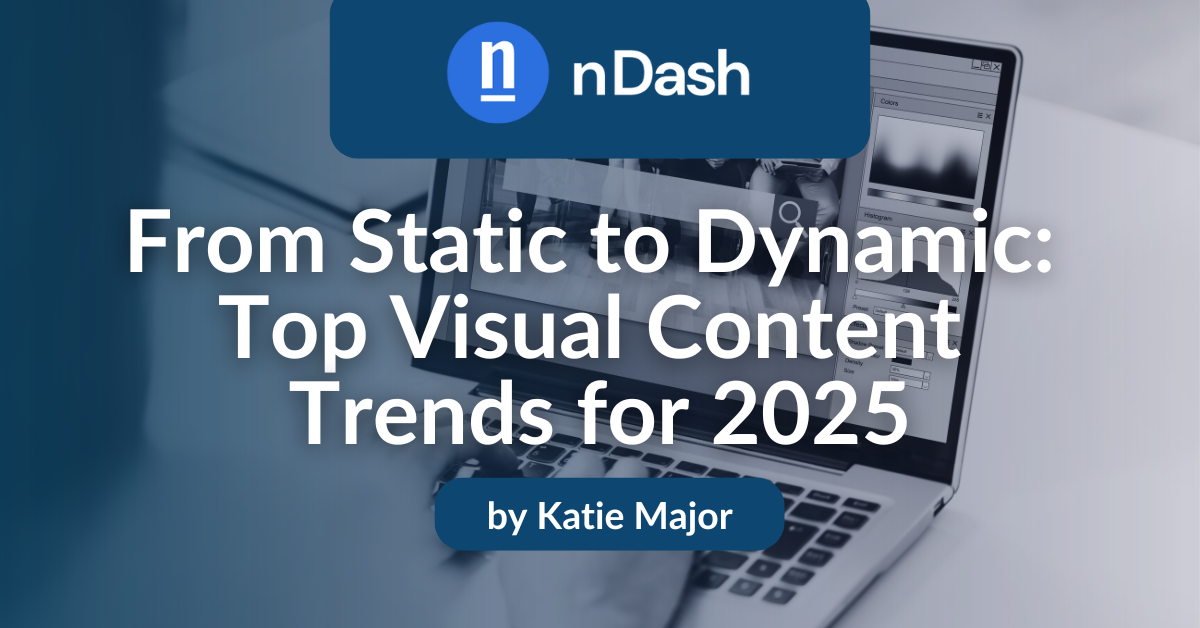If you’re not incorporating visual content into your strategy yet, consider this your sign to start taking it seriously.
The rise in video content over the past two to three years has also marked a rise in visual and sensory marketing. It doesn’t matter if you’re writing a blog article or planning out your social media content. It’s no longer about just compelling copy – a strong visual component is a must.
Statistics and human psychology aside, pairing written content with visual content is simply more compelling for your user. Yet, the statistics do show that it works. HubSpot says 89% of businesses use video marketing, and 93% of marketers say it’s an integral part of their strategy.
Mobile browsing accounts for over 50% of website traffic. Your potential audience is tapping, scrolling, and swiping in search of dopamine after a hard day or a solution to a problem. Is your visual content compelling enough to stop the scroll, or are you blending into the rest of the static?
Visual Content is Evolving Beyond Static Design
Static visuals will always have a place at the table, but they’re not enough to hold attention by themselves. Audiences are quickly becoming more accustomed to flashy, immersive feeds, and that is becoming the new standard. We won’t be going backward.
Marketers should experiment with motion and interactivity to improve engagement and reduce bounce rates. Motion-based content is especially important on mobile-first platforms, where static assets are easier to ignore.
Visual Content with Motion Graphics
It’s easy to think that visual content is just for social media, but the possibilities touch every platform, including webpages. Here’s how:
- Animated infographics: Motion makes data easier – and more enjoyable – to digest
- Explainer visuals: Easily break down a process step-by-step with movement
- Comparison charts: Users can toggle between options or highlight key differences without leaving a webpage
- Scroll-triggered animations: Reveal content gradually as someone navigates the page. This keeps scrolling feeling fresh and engaging
- Hover effects: Add subtle interactions that guide attention or offer more context without clutter
- Layered visuals: Use depth, motion, and smart transitions to create that immersive, almost tactile experience
- Sliders and hotspots: Let users explore visuals interactively, whether they’re scrolling through product angles or tapping for more info
- Before-and-after toggles: Great for showcasing transformations, upgrades, or side-by-side comparisons
- Quizzes and interactive modules: Turn content into a two-way experience that captures attention
Incorporate subtle animations and scroll-triggered effects on key landing pages to guide user attention and modernize the browsing experience.
A strong example of this is Apple’s iPhone comparison feature. Users can toggle through colors and models easily while staying on the same page. The product webpage features neat iPhone-style controls, and the mobile version lets users view the device in augmented reality (AR).
As marketers, we’ve also heard plenty about ‘hooking’ your audience, but this usually applies to social media. A touch of movement and feedback on a webpage is a ‘hook’ in and of itself. We’re seeing more websites embrace a new version of the user experience.
Interactive Visual Content Captures Attention
Strong, interactive visuals aren’t just for grabbing attention; they hold it too. Quizzes, sliders, toggles, and comparison charts involve your user in the experience.
This has a real-world impact on your metrics like time-on-page, scroll-depth, and engagement. These are signals that tell search engines that your content is worth spending time on. Adding interactive elements like quizzes or sliders can boost dwell time and signal value to search engines, improving both UX and SEO performance.
Building a Strong Visual Content System for Your Brand
Great visuals and an enjoyable user experience are ideal for your numbers, but it’s also great for brand recognition.
Remember, you don’t need the flashiest option right away. It’s about consistency and building something that unmistakably feels like your brand. Then you can play with visual elements that feel right to you, not just because they’re there.
As an example, Disney has used the same Tinkerbell animation over their loading-screen logo for decades. It’s not the flashiest, it’s not the most unique, but it works. It’s become deeply recognizable in a way that has stretched across generations.
A scalable and systematic approach to design ensures your brand is recognizable across multiple channels. Systems also naturally reduce rework and increase production speed over time.
Creating a Visual Content Identity
Start with the basics. Fonts, iconography, color palettes, and imagery style are the core parts of your brand’s visual soul.
When you align these elements across assets and platforms, it helps your content feel more polished and iconic to you. The basics are the foundation that will grow with your brand. Establish a documented visual identity to empower your team and external creators to make on-brand content with minimal oversight.
Using Templates to Scale Visual Content Production
Style guides, email modules, and social media templates will save your team unnecessary time spent on fixing consistency issues.
These assets also remove design fatigue and make content production much more accessible for everyone on your team. As an example, your new copywriter might not need to know every hex code. Yet, understanding your brand’s colors can help them shape the tone and mood of the words they write.
Templates save time and make high-volume content production accessible, even for non-designers on your team.
Video is Essential Visual Content in Modern Marketing
We’ve discussed visual elements on webpages; now, let’s talk about the medium that is changing the face of marketing. Video content.
Video content is the ultimate in visual storytelling strategy. Adam Mosseri, head of Instagram, said in 2025 that videos get “…more likes, more views, more watch time.” He also mentioned that most people spend their time on Instagram watching videos. A study by Buffer in 2024 showed that Reels get 36% more reach than any other media type on Instagram.
If you open TikTok or IG Reels, you’re looking for something. Maybe it’s reassurance, a laugh, a how-to. And often, you’ll scroll until you find it. Whatever the motive, video is now a default expectation for audiences seeking visual content that entertains and educates.
If video isn’t already part of your marketing mix, now is the time to start, especially short-form formats that can be produced with minimal resources.
Short-Form Video Content Trends
TikTok and Instagram Reels have a massive influence on visual content creation strategies. TikTok usually sets the tone for audio, visual, and editing trends, many of which trickle over to Instagram.
Staying on top of one platform will often inform strategy for another. This is especially true when it comes to pacing, visual hooks, and content that stops the scroll. Once you know what works for audiences on both platforms, you know what videos will cross over well.
Use TikTok trends to inform Instagram strategy. This cross-platform thinking helps ensure your brand stays timely and visible across channels.
What’s Working Right Now
Instagram video editing best practices tend to favor a slightly more polished approach. Instagram is very brand-friendly. In many cases, a strong bank of b-roll (secondary footage) and a solid copywriting strategy will take brands very far.
TikTok is much freer and raw – almost anything goes. Aesthetic content does have its place on TikTok, but ‘talking head’ videos, skits, ‘vlogs,’ and ‘storytimes’ will often go viral.
When it comes to editing, prioritize high-quality footage with intentional movement. The general rule is to keep clips short and snappy – every second should earn its place to keep viewers engaged.
Making Video Visual Content Accessible
Most users across all social media platforms will scroll with the sound off. In most everyday moments, scrolling with the sound on just isn’t practical. Many users are Deaf or hard of hearing. Prioritize accessibility in video editing with captions and text overlays. This widens reach, supports compliance, and boosts retention on sound-off platforms.
Instagram and TikTok will have automated closed captions ready to generate in their respective editors. Third-party editing software like CapCut and InShot will have extensive customization options for text overlay and closed captions.
Authentic Visual Content Is Outperforming Polished Campaigns
In 2025, there has been a marked shift in viewer preference toward raw, relatable visuals that feel more human and trustworthy.
It’s what big-name influencers have made popular in the last 3-4 years; they know what their audience wants to see. It’s what performs – their audience wants to be taken along for the ride, so to speak.
And, if it worked for your favorite influencer, why shouldn’t it work for your brand? With a strategic approach, it’s easier than you think to make your social content interesting and engaging.
Experiment With Becoming A Creator
Brands can emulate this with vlogs, trends, skits, behind-the-scenes sneak peeks, and raw ‘talking head’ videos. It’s effective, and it can be fun for the whole team.
It doesn’t mean you should abandon high-quality video, but your content doesn’t have to be as curated. Raw authenticity is accessible, and it creates stronger emotional connections with viewers.
Many brands have also explored creator-style text overlay copy. For example, instead of ‘5 healthy meals to cook this week,’ try ‘My favorite 5 meals that I keep on rotation as a busy working mom of two.’ See the difference? It’s more specific to the ideal customer, it’s relatable, and it’s coming from a place of authentic leadership.
Audiences are craving connection. Experiment with behind-the-scenes or unscripted formats to build authenticity without compromising brand values.
AI and the Future of Visual Content Creation
Generative AI is rapidly changing the way content marketing design is created – and it’s not going anywhere.
Automating Visual Content with AI Tools
Tools like Sora, Midjourney, DALL·E, and Canva AI are making it easier than ever to create compelling visual content. Blog graphics, mockups, resizing, photo editing, and other creative tasks are made much easier..
Even Instagram is prioritizing fun visual effects with their new tool, Restyle. Still in early development, Restyle is built into Instagram’s new editing app, Edits. Open prompting is not supported yet, but any user can play with limited presets right now.
Sora, Midjourney, and other AI tools were only launched in the last four years. Edits and Restyle were both launched in 2025. It’s easy to speculate wildly about how AI may shape content marketing in 2, 5, and 10 years.
Balancing AI Visual Content with Human Oversight
Critical thought and human intervention are crucial when using AI in your workflow.
Without clear branded visuals, AI content can quickly veer into generic or off-brand territory. That’s why human oversight is so important.
Designers and marketers still need to guide the creative direction, define visual rules, and make the final call. AI is a great assistant, but it’s not a replacement for a strong design and marketing team. They are human, and they will have a nuanced, human-level understanding of your brand in ways AI cannot.
It’s also worth noting that using AI-generated images is not currently protected by U.S. copyright laws.
Adapting Your Brand to the Future of Visual Content
Staying ahead of visual trends isn’t about flashy videos or the latest in visual effects. It’s about moving with the times, staying relevant, and delivering a great user experience.
Done right, visual effects and video production boost engagement, reinforce brand identity, and build trust across every content touchpoint.
It’s not about playing to the tune of the latest algorithmic changes – it’s about balancing great content with evolving visual trends. Your brand’s ability to show up clearly and consistently will be what keeps people coming back.
About the Author

Katie Major is a versatile marketing professional with a passion for content creation and strategic storytelling. She leads creative initiatives as Lead Creative at Major Marketing and serves as a Content Strategist and Copywriter at Katherine Major Creative. To learn more about Katherine — and to have her write for your brand — be sure to check out her nDash profile page.
